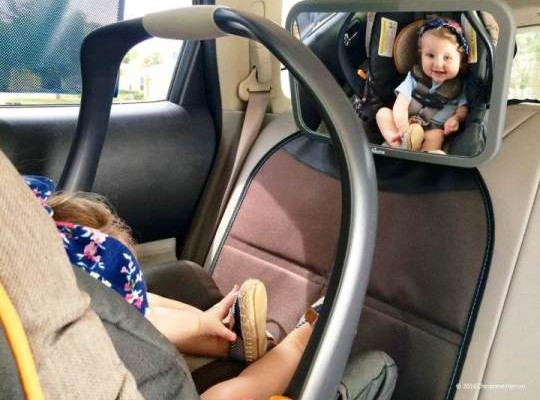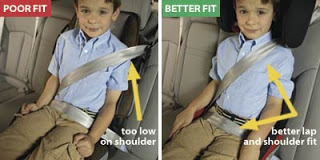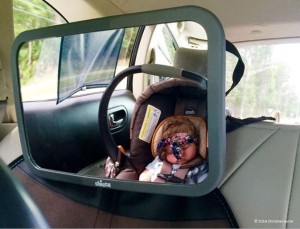Tag Archive: child safety seat

Baby Mirror: Safe Or Distracting?
May 17, 2016
A baby mirror to monitor the baby in the back seat of the car has become a popular gift at baby showers over the last few years and for good reason. The safest place for a baby in a car is securely fastened into a rear-facing infant seat mounted in the rear seat of the vehicle. That makes it difficult for the parents to see the child so, a forward facing baby mirror mounted over the infant safety seat is the best compromise. However, the question comes up, is a baby mirror a good safety tool or just another distraction added to all the other distractions that make driving so dangerous today? The answer is; it all depends on how it’s used by the driver.
Distraction:
Parents of a newborn baby love watching this incredible miracle that they’ve created but you can watch too much. If a driver is tempted to watch for the baby’s reaction while talking to her, he or she can take too much time from the critically important job of keeping his or her eyes on the road.
Studies have shown that most traffic crashes happen within three seconds of a driver distraction. If you take your eyes off the road to look at your baby for just two seconds while driving at 45 mph, your vehicle will travel over 130 feet. A lot can happen in that time and distance. If an emergency should happen in that space, it’ll take, on average, an additional 84 feet to bring your car to a stop. Good thing you have a good, safe baby seat.
To protect that precious bundle of joy, the driver needs to keep his or her eyes on the road at all times. Give the baby the same amount of attention that you would give to other vehicles in your rearview mirror. Just a quick glance every 10 to 15 seconds just to make sure everything’s OK. Make sure that your rearview mirror is positioned on the road behind and not aimed mostly at the baby mirror.
Safety Tool:
As long as you’re not allowing the baby mirror to be a distraction, it can be an excellent safety tool.
Babies are constantly exploring and learning new things. One thing they tend to learn, as early as 12 months, is that they’re capable of unbuckling their seat harness and crawling out of their child seat. One study showed that 75% of children who discover they can unbuckle their seatbelt were ages three and under. Once they make this miraculous discovery, it can be very hard to keep them buckled up. Checking to ensure that your child is safely buckled in is one of the best reasons for investing in a baby mirror. If your child is getting out of his or her seat, don’t panic and never try to deal with it from the driver’s seat while the car is in motion. Pull as far off the side of the road as possible, then get out and deal with the situation.
Remember that the safest place to interact with your child is at home. While you’re driving, pay attention to the road so that you can both get home safely.

Child Safety Seats Have An Expiration Date
October 14, 2011
In these hard economic times, when parents have a new child on the way, it is often tempting to use a hand-me-down child safety seat or a used child seat purchased from a second hand store but, did you know that child safety seats have expiration dates?
It is a little known fact that child safety seats have expiration dates; usually six years from the manufacture date. There is a very good reason for this. Child safety seats are made from synthetic, petroleum based plastics and fabrics. While these materials are excellent for this purpose and make for a very strong and reliable child protective seat, they are subjected to a lot of harmful environmental factors that can weaken them over the years.
Most child seats remain in the car and internal temperatures inside the car in the summer can easily reach 130 to 140 degrees and over time, this can lead to a breakdown of the plastic materials. Exposure to the sun is also harmful. Synthetic fabrics, especially nylon don’t tolerate long periods of direct exposure to the sun very well. When exposed to the sun over long periods, the synthetic fabrics can become brittle and break; not something you want a safety belt to do.
Read more about: Summer Heat Warnings – Never Leave Children Alone in Cars
So, while a used seat may look perfectly fine, there may be damage that is too small to see that can grow over time. Your little passenger is too precious to take that chance. Most seats have the expiration date embossed in the plastic on the bottom of the seat. When considering a used car seat, check the expiration date and make sure that your child will have outgrown it before it expires.
Parents should also remember that children who outgrow the child safety seat should graduate into a booster seat until they are at least 4’9” tall. Lots of kids are graduated to seat belts too early and their small frames prevent the seat belt from fitting properly low over their hips. If the belt should rise up over their abdomen, they could be injured in a crash.
For more information on child safety seats and booster seats, visit the Insurance Institute for Highway Safety at: http://www.iihs.org/research/topics/child_restraints/default.html
For help in learning how to properly install and use a child seat, the National Highway Traffic Safety Administration has a web site that can direct you to a trained Child Passenger Safety Technician in your area who can teach you how to install your seat, answer any questions you may have, and give you additional information on child safety seats. To locate a Child Passenger Safety Technician, visit: http://www.nhtsa.gov/cps/cpsfitting/index.cfm
Photo: Compliments Insurance Institute for Highway Safety

Child Passenger Safety Week / Seat Check Saturday
September 1, 2011
Child Passenger Safety Week is coming up September 18 – 24 and there are a few issues to be aware of as we think about how to best protect the most precious cargo of all.
A small but interesting study by the Yale School of Medicine’s Department of Pediatrics revealed that large number of children are unbuckling themselves from their child safety seat while the car is in motion, making their risk of injury in a crash up to three and a half times greater. What is remarkable is that some of those children who unbuckle themselves are as young as 12 months old.
According to the Yale press release, “The team found that 75% of children who self-unbuckle were age three and under, with an age range of 12 to 78 months. Unbuckling was reported as early as 12 months of age and was more common in boys than girls. Of the children self-unbuckling, 43% did so while the car was in motion. Twenty-nine percent of children who unbuckle are in a five-point restraint and do so more commonly from the chest buckle. The most common parental response to self-unbuckling while the car was in motion was “pull over, reprimand, and re-buckle the child.”
If you, as a parent or grandparent, find your toddler unbuckling their seat belt, don’t try to deal with it while the car is in motion. The safest possible action is to slow, find a place to pull over as quickly as possible and then, reprimand and re-buckle your child; trying to deal with the situation while the car is in motion puts both of your lives at risk.
In an article on this study in WebMD.com, Lorrie Walker, training manager and technical advisor for Safe Kids USA, an advocacy group was quoted as saying; “This study raises questions about how the child restraint was used,”. She went on to say that “Federal motor vehicle safety standard 213 requires the buckle to release using between 9 and 14 pounds of pressure. It is often challenging for an adult to unbuckle the harness.” She wondered if the buckle wasn’t adequately locked in some of those cases.
The National Highway Traffic Safety Administration (NHTSA) estimates that as many as three out of four parents aren’t installing their child safety seat correctly. If you have doubts about whether or not you are properly buckling the harness or whether or not the child safety seat is installed correctly, there is a service that you can use to get training and guidance on the proper use of a child safety seat. NHTSA has a website called the “Child Safety Seat Inspection Station Locator“. In this site, you can plug in your state or zip code and find technicians who can show you how to properly install and use the child safety seat. These Child Passenger Safety Technicians receive training and certification based on a standardized nationally recognized curriculum.
Using the Child Safety Seat Inspection Station Locator, you can find a nearby Child Passenger Safety Technician, usually at your county’s Department of Public Safety or the local police or fire department. You will need to make an appointment with the technician and allow about 20 minutes to complete the training. Expectant parents should schedule an appointment about three weeks before their child’s due date. This is a free service.
You should remember also that child safety seats aren’t just for babies and toddlers. The Insurance Institute for Highway Safety has determined that children are being graduated from child safety seats to seat belts too early. In small children, instead of resting low over their hips and pushing against their hip bones, the seat belt tends to ride up over their abdomen where it can cause internal injuries in a crash. Children who graduate out of child safety seats should move into a booster seat until they are at least 4’9” tall or anywhere from 9 to 11 years of age.
While talking about car seats, it is important to remember never to leave your child unattended in a car. Even when the outside temperature is cool, the temperatures inside a car can quickly rise up to more than 100 degrees on a sunny day. Kids and Cars.org estimates that, on average, 38 children die in hot cars each year from heat-related deaths after being trapped inside motor vehicles.

